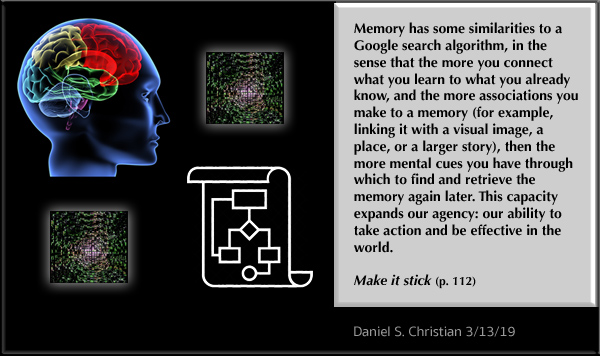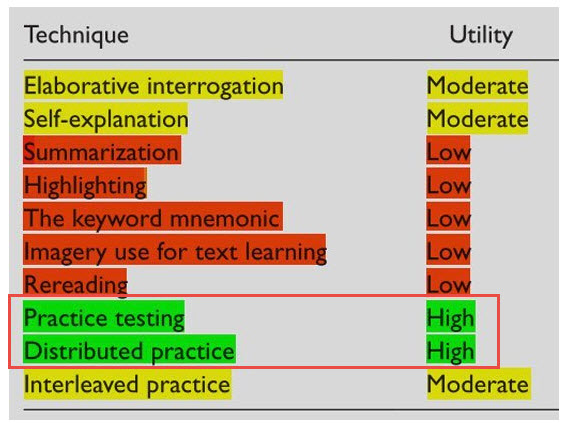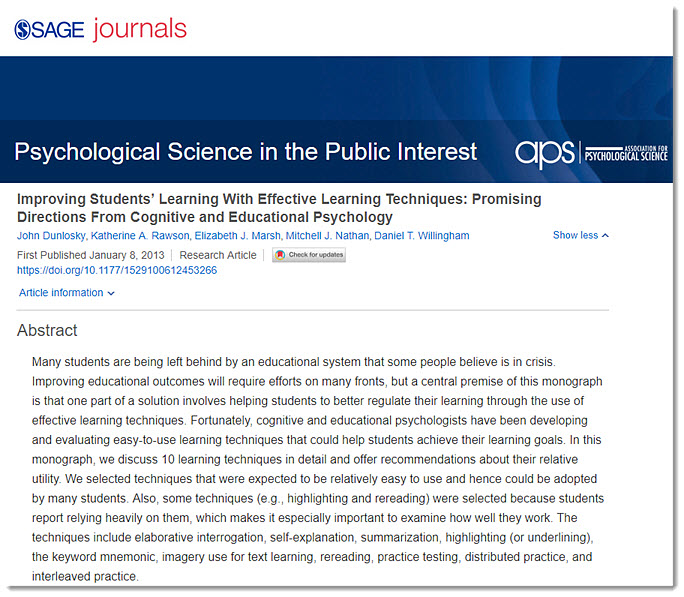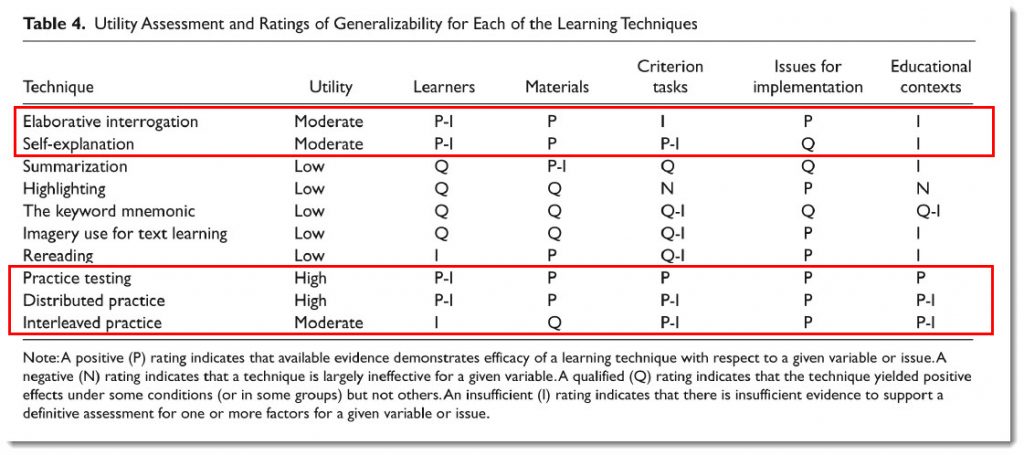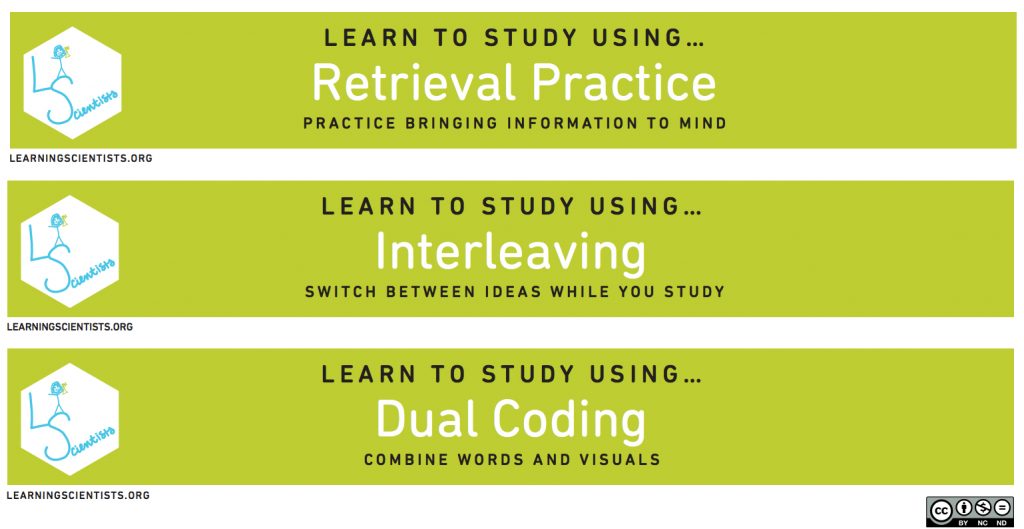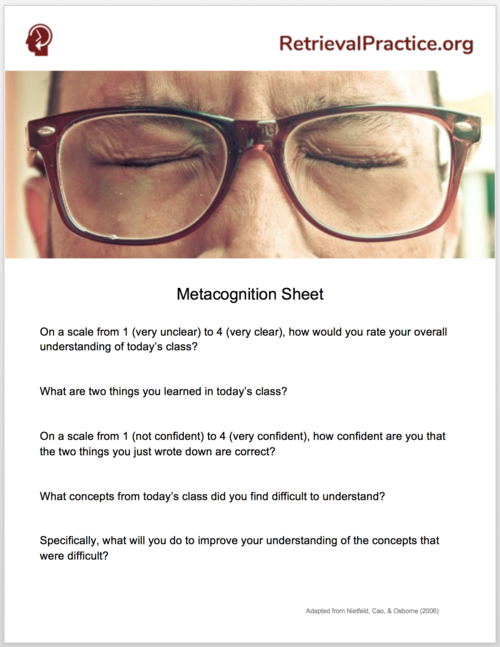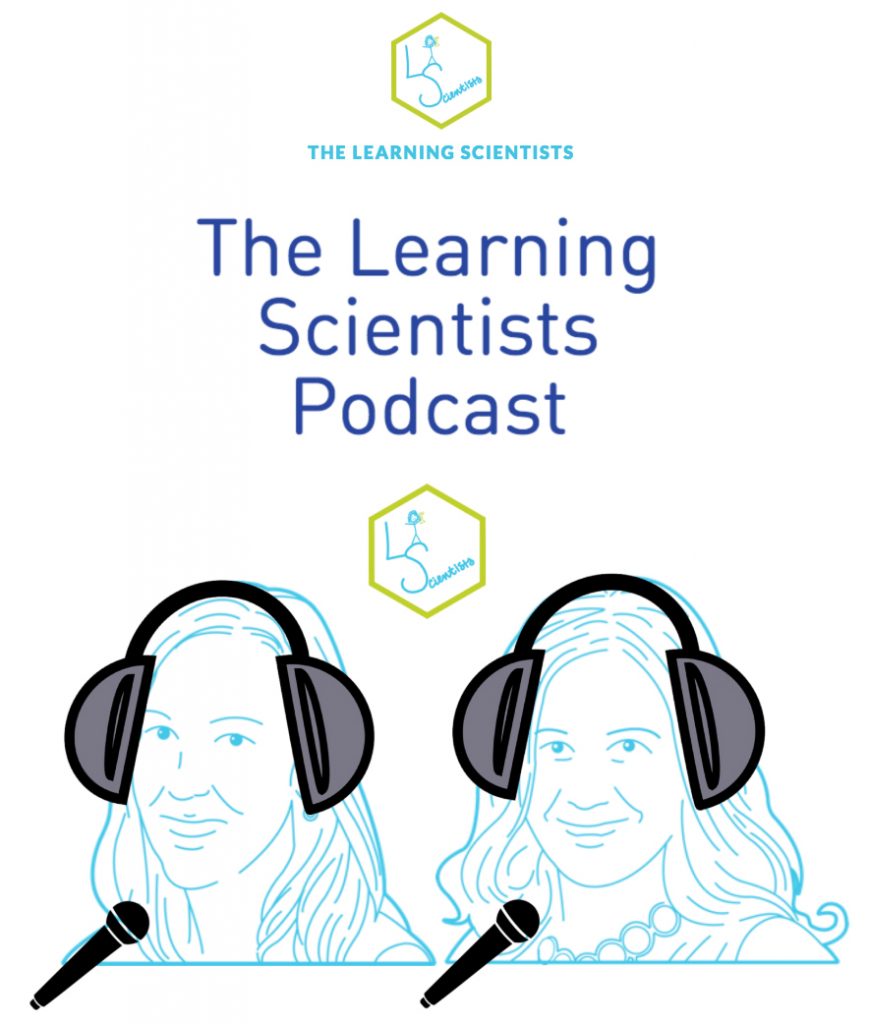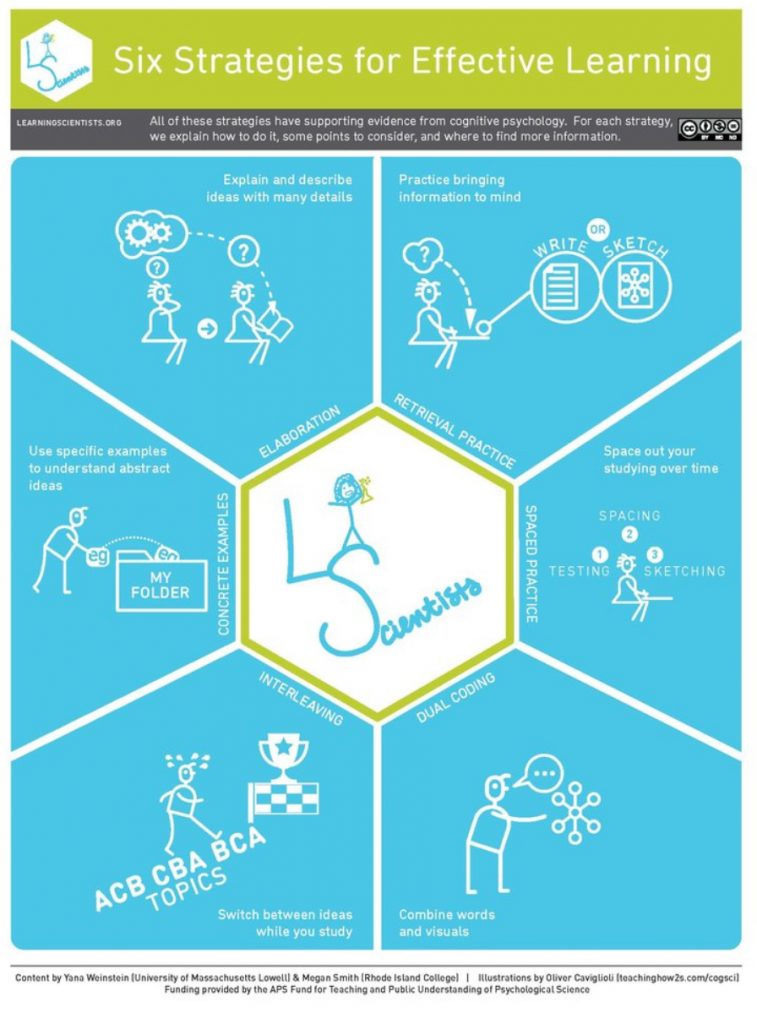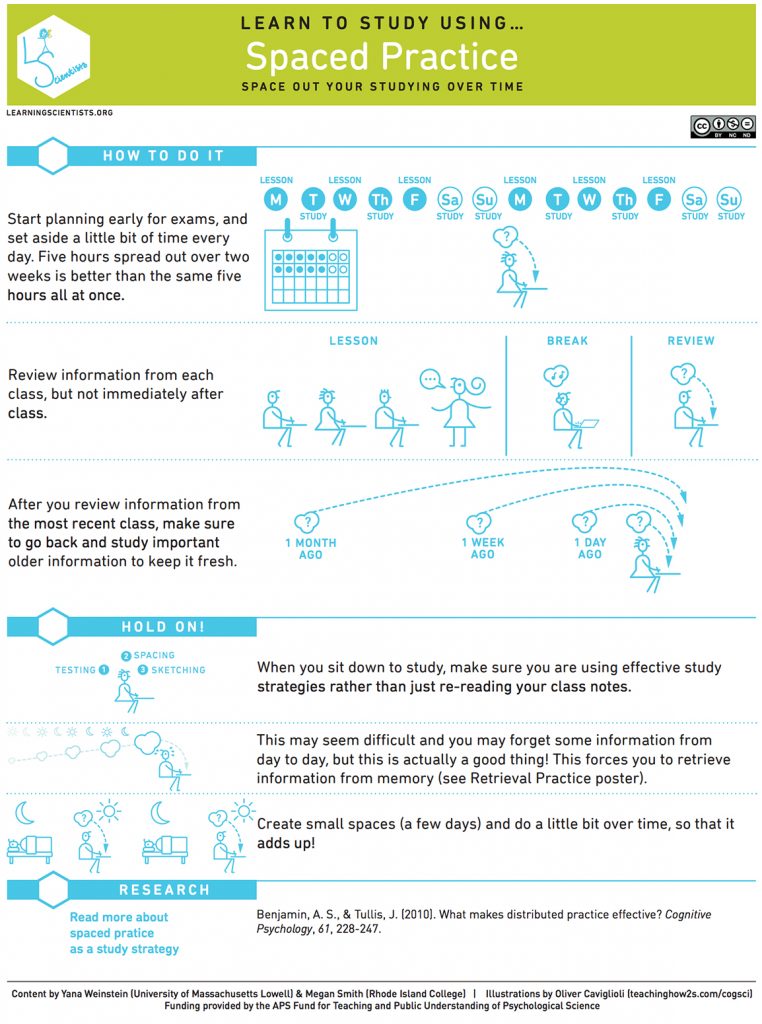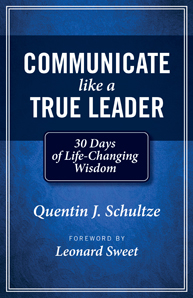The Lesson You Never Got Taught in School: How to Learn! — from bigthink.com by Simon Oxenham (from 2/15/13)
Psychological Science in the Public Interest evaluated ten techniques for improving learning, ranging from mnemonics to highlighting and came to some surprising conclusions.
Excerpts:
Practice Testing (Rating = High)
This is where things get interesting; testing is often seen as a necessary evil of education. Traditionally, testing consists of rare but massively important ‘high stakes’ assessments. There is however, an extensive literature demonstrating the benefits of testing for learning – but importantly, it does not seem necessary that testing is in the format of ‘high stakes’ assessments. All testing including ‘low stakes’ practice testing seems to result in benefits. Unlike many of the other techniques mentioned, the benefits of practice testing are not modest – studies have found that a practice test can double free recall!
Distributed Practice (Rating = High)
Have you ever wondered whether it is best to do your studying in large chunks or divide your studying over a period of time? Research has found that the optimal level of distribution of sessions for learning is 10-20% of the length of time that something needs to be remembered. So if you want to remember something for a year you should study at least every month, if you want to remember something for five years you should space your learning every six to twelve months. If you want to remember something for a week you should space your learning 12-24 hours apart. It does seem however that the distributed-practice effect may work best when processing information deeply – so for best results you might want to try a distributed practice and self-testing combo.
Also see:
- Improving Students’ Learning With Effective Learning Techniques: Promising Directions From Cognitive and Educational Psychology
John Dunlosky, Katherine A. Rawson, Elizabeth J. Marsh, Mitchell J. Nathan, Daniel T. Willingham
First Published January 8, 2013 | Research Article
https://doi.org/10.1177/1529100612453266
- Study smart — from apa.org by Lea Winerman; as recommended by Daniel Willingham here
Make the most of your study time with these drawn-from-the-research tips.
Per Willingham (emphasis DSC):
- Rereading is a terribly ineffective strategy. The best strategy–by far — is to self-test — which is the 9th most popular strategy out of 11 in this study. Self-testing leads to better memory even compared to concept mapping (Karpicke & Blunt, 2011).
Three Takeaways from Becoming An Effective Learner:
- Boser says that the idea that people have different learning styles, such as visual learning or verbal learning, has little scientific evidence to support it.
- According to Boser, teachers and parents should praise their kids’ ability and effort, instead of telling them they’re smart. “When we tell people they are smart, we give them… a ‘fixed mindset,’” says Boser.
- If you are learning piano – or anything, really – the best way to learn is to practice different composers’ work. “Mixing up your practices is far more effective,” says Boser.
Cumulative exams aren’t the same as spacing and interleaving. Here’s why. — from retrievalpractice.org
Excerpts (emphasis DSC):
Our recommendations to make cumulative exams more powerful with small tweaks for you and your students:
- Cumulative exams are good, but encourage even more spacing and discourage cramming with cumulative mini-quizzes throughout the semester, not just as an end-of-semester exam.
- Be sure that cumulative mini-quizzes, activities, and exams include similar concepts that require careful discrimination from students, not simply related topics.
- Make sure you are using spacing and interleaving as learning strategies and instructional strategies throughout the semester, not simply as part of assessments and cumulative exams.
Bottom line: Just because an exam is cumulative does not mean it automatically involves spacing or interleaving. Be mindful of relationships across exam content, as well as whether students are spacing their study throughout the semester or simply cramming before an exam – cumulative or otherwise.
From DSC:
We, like The Learning Scientists encourages us to do and even provides their own posters, should have posters with these tips on them throughout every single school and library in the country. The posters each have a different practice such as:
- Spaced practice
- Retrieval practice
- Elaboration
- Interleaving
- Concrete examples
- Dual coding
That said, I could see how all of that information could/would be overwhelming to some students and/or the more technical terms could bore them or fly over their heads. So perhaps we could boil down the information to feature excerpts from the top sections only that put the concepts into easier to digest words such as:
- Practice bringing information to mind
- Switch between ideas while you study
- Combine words and visuals
- Etc.
Humans are hardwired to forget. But research shows that strategies like peer-to-peer explanations, regular review, and interleaving can boost retention. pic.twitter.com/0IVVz2M3FJ
— edutopia (@edutopia) December 6, 2018
From DSC:
This is where the quizzing features/tools within a Learning Management System such as Canvas, Moodle, Blackboard Learn, etc. are so valuable. They provide students with opportunities for low-stakes (or no-stakes) practice in retrieving information and to see if they are understanding things or not. Doing such formative assessments along the way can point out areas where they need further practice, as well as areas where the students are understanding things well (and only need an occasional question or two on that item in order to reduce the effects of the forgetting curve).
Why giving kids a roadmap to their brain can make learning easier — from edsurge.com by Megan Nellis
Excerpts:
Learning, Down to a Science
Metacognition. Neuroplasticity. Retrieval Practice. Amygdala. These aren’t the normal words you’d expect to hear in a 15-year-old rural South African’s vocabulary. Here, though, it’s common talk. And why shouldn’t it be? Over the years, we’ve found youth are innately hungry to learn about the inner workings of their mind—where, why and how learning, thinking and decision-making happens. So, we teach them cognitive science.
…
Over the next three years, we teach students about the software and hardware of the brain. From Carol Dweck’s online Brainology curriculum, they learn about growth mindset, memory and mnemonics, the neural infrastructure of the brain. They learn how stress impacts learning and about neuroplasticity—or how the brain learns. From David Eagleman and Dan Siegel, they learn about the changing landscape of the adolescent brain and how novelty, emotionality and peer relationships aid in learning.
…
Pulling from books such as Make It Stick and How We Learn, we pointedly teach students about the science behind retrieval practice, metacognition and other strategies. We expressly use them in our classes so students see and experience the direct impact, and we also dedicate a whole class in our program for students to practice applying these strategies toward their own academic learning from school.
From DSC:
With thanks going out to Nelson Miller, Associate Dean at WMU-Cooley Law School, a Professor of Law, and an author of many of his own books…below are some of my notes and reflections on the following article:
- Teaching Law Students How to Become Metacognitive Thinkers: Helping Students Develop Their Mental Apps
The Appalachian Journal of Law, Forthcoming
Edwin S. Fruehwald
October 6, 2017
B. Teaching Metacognition in the Classroom
Because preparation and planning are vital to learning, law professors should set clear learning goals at the beginning of the semester and at the beginning of each unit and hand them out to the students, so that the students know what they are expected to learn in the class and to help them set their own goals for the class. (p. 14 of 61)
There are three criteria for creating goals (Insert from DC: i.e., learning objectives):
- “the terminal behavior, or what the learner must be able to do by the end of instruction,”
- “the conditions of demonstration, or the circumstances under which the learner must be able to perform the terminal behavior,” and
- “the standards or criteria, or how well the learner must be able to perform the objective for the instructor to conclude that the learner has met it.”
Goals for a doctrinal class should include substantive, skills (process), and professionalism goals
Teachers need to teach metacognitive skills explicitly. As one author has stated, “[i]f the knowledge is never shared through discussion, modeling, or explicit instruction, it is difficult for students to learn.” Moreover, being explicit about the learning process is a key to creating a learning self-identity. Knowledge of metacognitive strategies, such as those for memorization, studying, and reading, makes students more likely to use them, especially if they are told that such strategies will improve their performance and grades. (p. 15)
Professors should say out loud their thinking process when working sample problems “Modeling of strategies”–talking out loud about the steps the teacher uses when solving a particular problem–helps students develop metacognitive process skills (mental apps) by providing models. When students are given a problem to solve they generally focus on task completion, rather than the problem-solving process. Consequently, they will usually adopt a trial and error approach, rather than the process the teacher wants them to employ. Modeling of strategies helps solve this problem. Similarly, telling the students why the professor is employing a particular strategy helps conditional metacognition. After giving the demonstration, the professor should also ask questions that determine whether the students understood the processes for coming up with the answers (the problem-solving strategies). Teachers should also help students create strategies for solving ill-defined problems. In sum, the teacher should demonstrate a sample problem’s thinking process in detail, explain why the teacher used that process, have students do similar problems, then give student’s feedback on their problem-solving skills. (p. 18)
An example of scaffolding is partially filling out a diagram, then letting the students finish it (the partial outline approach). Another one is giving students leading questions before they read a case. (p. 19)
Professors should teach their students how to listen in class. Active listening aids learning, while passive listening often results in little retention. Students should think about what they are hearing in class. How does the material relate to my prior knowledge? What is important and what is less important? How can I use this material later? Where would I put this material in an outline? Students should also critically evaluate what the professor is saying. Do I agree? Is there an alternative argument? What are the implications of this argument? Similarly, professors should teach students effective note taking. (p. 20)
Law professors should also help students with study strategies. Deciding what items to study, how to allocate study time, and what study strategies to use are types of metacognitive control. (p. 22)
Professors should help students use study strategies that reinforce long-term memory and create connections between concepts, processes, declarative knowledge, etc. One way of doing this is through repetition,
Experts advise at least four repetitions of material each at least once within a day for retention.
Professors should help their students develop reading strategies. Engaged teachers help their students extract meaning and comprehension from cases, rather than just producing empty briefs. (p. 23)
Well-designed formative assessments–assessments within the learning (during the semester)–that are related to course goals also aid in learning metacognition. This is because formative assessments force students to think about their thinking. As one scholar has asserted, “[a]ssessment methods and requirements probably have a greater influence on how and what students learn than any other single factor.” As one legal educator has noted, “[f]ormative assessment . . . is designed to provide feedback and guide students to improve and learn further, based on feedback that enhances their capacity to build on what they know and address areas of misunderstanding.” As a group of researchers have pointed out, “[i]f the assessments reflect the contexts in which the knowledge is to be used, this is nothing more than practice.”
Under the “testing effect,” “learning and memory for material is improved when time is spent taking a test on the material, versus spending the same amount of time restudying the material” because testing engages students in the subject matter. Also, testing uses retrieval, which as stated above, helps long-term retention. In addition, students retain more if they get feedback on their assessment because without feedback students don’t why they’ve made mistakes. Similarly, students who receive feedback are generally more engaged, more positive about law school, and spend more time studying than those who do not receive feedback. In addition, feedback about process is generally more useful than feedback about product. (p. 32)
There are many different kinds of formative assessments, including writing assignments, problem-solving exercises, multiple choice tests, observations, and [daily/weekly quizzes]. For instance, a professor could give the students a problem-solving exercise at the end of a unit to do at home, then go over that exercise in class. Likewise, the professor could give the students a take-home multiple choice test that could be graded by a teaching assistant. Similarly, the professor could give the students a complaint, a corporate document, or a lease and have the students find errors. Finally, the students could draft a contract clause after the unit concerning that clause. (p. 33)
The general criteria for designing effective formative assessments are:
- formulate learning objectives and performance standards; publicize them to the students
- design the assessment tool
- design instruction and activities to enable the students to learn what they need to fulfill the assessment task
- provide feedback/discussion — the teacher and student must discuss and use the results of the assessment measure to further promote learning and teaching
As one scholar has noted, “students learn more effectively when their teachers provide them with the criteria by which they are evaluated.” One way of doing this is through rubrics–“sets of detailed written criteria used to assess student performance.” (p.34)
“[R]ubrics are an attempt to break the grade down into a series of scores that pertain to various aspects of the assignment.” Rubrics identify how a student performed on a particular task, skill, or area. They include both characteristics and levels of quality. They can be a scoring rubric, an instructional rubric, or both. Rubrics should be related to the teacher’s goals for the class. They can employ grades, numbers, or categories.
“Successful students take charge of their own learning.”
From DSC:
My concern with this great article is that it’s a lot of valuable information to take in all at once — let alone try to act upon that information! I’ve only touched upon a subset of the items within that article. As such, it’s too much information for faculty members and instructional designers to remember and to act upon – as a whole.
This is why I’m such a fan of blogging and chunking valuable information up into much smaller pieces — then sending out such information piece by piece, where it’s much easier to digest and act upon.
From DSC:
I just found out about the work going out at LearningScientists.org.
I was very impressed after my initial review of their materials! What I really appreciate about their work is that they are serious in identifying some highly effective means of how we learn best — pouring over a great deal of research in order to do so. But they don’t leave things there. They help translate that research into things that teachers can then try out in the classroom. This type of practical, concrete help is excellent and needed!
- Daniel Willingham and some of his colleagues take research and help teachers apply it as well
- Another person who does this quite well is Pooja Agarwal, an Assistant Professor, Cognitive Scientist, & former K-12 Teacher. Pooja is teaming up with Patrice Bain to write a forthcoming book entitled, Powerful Teaching: Unleash the Science of Learning! She founded and operates the RetrievalPractice.org site.)
From the LearningScientists.org website (emphasis DSC):
We are cognitive psychological scientists interested in research on education. Our main research focus is on the science of learning. (Hence, “The Learning Scientists”!)
Our Vision is to make scientific research on learning more accessible to students, teachers, and other educators.
Click the button below to learn more about us. You can also check out our social media pages: Facebook, Twitter, Instagram, & Tumblr.
They have a solid blog, podcast, and some valuable downloadable content.
In the downloadable content area, the posters that they’ve created (or ones like them) should be posted at every single facility where learning occurs — K-12 schools, community colleges, colleges, universities, libraries of all kinds, tutoring centers, etc. It may be that such posters — and others like them that encourage the development of metacognitive skills of our students — are out there. I just haven’t run into them.
For example, here’s a poster on learning how to study using spaced practice:
Anyway, there’s some great work out there at LearningScientists.org!
Also relevant here, see:
- Science-based tips to improve learning — from qbi.uq.edu.au
Use these six tips to help improve the power of your brain.
From DSC:
Low-stakes formative assessments offer enormous benefits and should be used extensively throughout K-12, higher education, L&D/corporate universities, in law schools, medical schools, dental schools, and more.
Below are my notes from the following article – with the provided emphasis/bolding/highlighting via colors, etc. coming from me:
Duhart, Olympia. “The “F” Word: The Top Five Complaints (and Solutions) About Formative Assessment.” Journal of Legal Education, vol. 67, no. 2 (winter 2018), pp. 531-49. <– with thanks to Emily Horvath, Director of Academic Services & Associate Professor, WMU-Cooley Law School
“No one gets behind the wheel of a car for the first time on the day of the DMV road test. People know that practice counts.” (p. 531)
“Yet many law professors abandon this common-sense principle when it comes to teaching law students. Instead of providing multiple opportunities for practice with plenty of space to fail, adjust, and improve, many law school professors place almost everything on a single high-stakes test at the end of the semester.” (p. 531)
“The benefits of formative assessment are supported by cognitive science, learning theory, legal education experts, and common sense. An exhaustive review of the literature on formative assessment in various schools settings has shown that it consistently improves academic performance.” (p. 544)
ABA’s new formative assessment standards (see pg 23)
An emphasis on formative assessments, not just a mid-term and/or a final exam – which are typically called “summative assessments.”
“The reliance on a single high-stakes exam at the end of the semester is comparable to taking the student driver straight to the DMV without spending any time practicing behind the wheel of a car. In contrast, formative assessment focuses on a feedback loop. It provides critical information to both the students and instructor about student learning.” (p. 533)
“Now a combination of external pressure and a renewed focus on developing self-regulated lawyers has brought formative assessment front and center for law schools.” (p. 533)
“In fall 2016, the ABA implemented new standards that require the use of formative assessment in law schools. Standard 314 explicitly requires law schools to use both formative and summative assessment to “’measure and improve’ student learning.” (pgs. 533-534)
Standard 314. ASSESSMENT OF STUDENT LEARNING
A law school shall utilize both formative and summative assessment methods in its curriculum to measure and improve student learning and provide meaningful feedback to students.
Interpretation 314-1
Formative assessment methods are measurements at different points during a particular course or at different points over the span of a student’s education that provide meaningful feedback to improve student learning. Summative assessment methods are measurements at the culmination of a particular course or at the culmination of any part of a student’s legal education that measure the degree of student learning.
Interpretation 314-2
A law school need not apply multiple assessment methods in any particular course. Assessment methods are likely to be different from school to school. Law schools are not required by Standard 314 to use any particular assessment method.
From DSC:
Formative assessments use tests as a learning tool/strategy. They help identify gaps in students’ understanding and can help the instructor adjust their teaching methods/ideas on a particular topic. What are the learners getting? What are they not getting? These types of assessments are especially important in the learning experiences of students in their first year of law school. All students need feedback, and these assessments can help give them feedback as to how they are doing.
Practice. Repetition. Feedback. <– all key elements in providing a solid learning experience!
“…effective assessment practices are linked to the development of effective lawyers.” (pg. 535)
“Low-risk formative assessment give students multiple opportunities to make mistakes and actively engage with the material they are learning.” (p. 537)
Formative assessments force the students to practice recall. This is very helpful in terms of helping students actually remember the information. The spaced out practice of forcing recall – no matter how much the struggle of recalling it – aids in retaining information and moving items into longer-term memory. (See Make It Stick: The Science of Successful Learning by Peter C. Brown, Henry L. Roediger III, & Mark A. McDaniel). In fact, according to this book’s authors, the more the struggle in recalling the information, the greater the learning.
Formative assessments can help students own their own learning. Self-regulation. Provide opportunities for students to practice meta-cognition – i.e., thinking about their thinking.
“Lawyers need to be experts at self-regulated learning.” (p. 541)
The use of numerous, low-stakes quizzes and more opportunities for feedback reduces test anxiety and can help with the mental health of students. Can reduce depression and help build a community of learners. (p. 542)
“Millennials prefer interactive learning opportunities, regular assessments, and immediate feedback.” (p. 544)
Ideas:
- As a professor, you don’t have to manually grade every formative assessment. Technology can help you out big time. Consider building a test bank of multiple-choice questions and then drawing upon them to build a series of formative assessments. Have the technology grade the exams for you.
- Digital quizzes using Blackboard Learn, Canvas, etc.
- Tools like Socrative
- Alternatively, have the students grade each other’s work or their own work. Formative assessments don’t have to be graded or count towards a grade. The keys are in learners practicing their recall, checking their own understanding, and, for the faculty member, perhaps pointing out the need to re-address something and/or to experiment with one’s teaching methods.
- Consider the use of rubrics to help make formative assessments more efficient. Rubrics can relay the expectations of the instructors on any given assignment/assessment. Rubrics can also help TA’s grade items or even the students in grading each other’s items.
- Formative assessments don’t have to be a quiz/test per se. They can be games, presentations, collaborations with each other.
For further insights on this topic (and more) from Northwestern University, see:
New ABA Requirements Bring Changes to Law School Classrooms, Creating Opportunity, and Chaos –from blog.northwesternlaw.review by Jacob Wentzel
Excerpt:
Unbeknownst to many students J.D. and L.L.M. students, our classroom experiences are embarking upon a long-term path toward what could be significant changes as a trio of ABA requirements for law schools nationwide begin to take effect.
The requirements are Standards 302, 314, and 315 , each of which defines a new type of requirement: learning outcomes (302), assessments (314), and global evaluations of these (315). According to Christopher M. Martin, Assistant Dean and Clinical Assistant Professor at Northwestern Pritzker School of Law, these standards take after similar ones that the Department of Education rolled out for undergraduate universities years ago. In theory, they seek to help law schools improve their effectiveness by, among other things, telling students what they should be learning and tracking students’ progress throughout the semester. Indeed, as a law student, it often feels like you lose the forest for the trees, imbibing immense quantities of information without grasping the bigger picture, let alone the skills the legal profession demands.
…
By contrast, formative assessment is about assessing students “at different points during a particular course,” precisely when many courses typically do not. Formative assessments are also about generating information and ideas about what professors do in the classroom. Such assessment methods include quizzes, midterms, drafts, rubrics, and more. Again, professors are not required to show students the results of such assessments, but must maintain and collect the data for institutional purposes—to help law schools track how students are learning material during the semester and to make long-term improvements.
And/or see a Google query on “ABA new formative assessment standards”
Make it Stick: The Science of Successful Learning— by Peter C. Brown, Henry L Roediger III, and Mark A. McDaniel
Some of the key points and learning strategies they mention in the preface:
- The most effective learning strategies are not intuitive
- Spaced repetition of key ideas and the interleaving of different but related topics are two excellent teaching/learning strategies
Some the key points and learning strategies they mention in the first chapter:
- When they talk about learning they mean acquiring knowledge and skills and having them readily available from memory so you can make sense of future problems and opportunities.
- There are some immutable aspects of learning that we can probably all agree on:
- To be useful, learning requires memory, so what we’ve learned is till there later when we need it.
- We need to keep learning and remembering all our lives.
- Learning is an acquired skill and most effective strategies are counterintuitive
- Learning is deeper and more durable when it’s effortful
- We are poor judges of when we are learning well and when we’re not
- Rereading text and massed practice (i.e., cramming) of a skill or new knowledge are by far the preferred study strategies of learners of all stripes, but they”re also among the least productive. Rereading and cramming give rise to feeling of fluency that are taken to be signs of mastery, but for true mastery or durability these strategies are largely a waste of time.
- Retrieval practice — recalling facts or concepts or events from memory — is a more effective learning strategy than reviewing by rereading
- Flashcards are a simple example
- Retrieval strengthens the memory and interrupts forgetting
- A single simple quiz after reading a text or hearing a lecture produces better learning and remembering that rereading the text of reviewing lecture notes.
- Periodic practice arrest forgetting, strengthens retrieval routes, and is essential for hanging onto the knowledge you want to gain.
- Space out practice and interleave the practice of 2 or more subjects, retrieval is harder and feels less productive, but the effort produces longer lasting learning and enables more versatile application of it in later settings.
- Trying to solve a problem before being taught the solution leads to better learning, even when errors are made in the attempt.
- Learning styles are not supported by the empirical research.
- When you’re adept at extracting the underlying principles or “rules” that differentiate types of problems, you’re more successful at picking the right solutions in unfamiliar situations. This skill is better acquired through interleaved and varied practice than massed practice.
- In virtually all areas of learning, you build better mastery when you use testing as a tool to identify and bring up your areas of weakness.
- All learning requires a foundation of prior knowledge.
If you practice elaboration, there’s no known limit to how much you can learn. Elaboration is the process of giving new material meaning by expressing it in your own words and connecting it with what you already know. The more you can explain about the way your new learning relates to your prior knowledge, the stronger your grasp of the new learning will be, and the more connections you create that will help you remember it later.***
“When learning is hard, you’re doing important work.”
“Making mistakes and correcting them builds the bridges to advanced learning.”
Learning is stronger when it matters.^^^
- One of the most striking research findings is the power of active retrieval — testing — to strengthen memory, and the more effortful the retrieval, the stronger the benefit.
. - The act of retrieving learning from memory has 2 profound benefits:
- It tells you what you know and don’t know, and therefore where to focus further study
- Recalling what you have learned causes your brain to re-consolidate the memory
.
- To learn better and remember longer, [use]:
- various forms of retrieval practice, such as low-stakes quizzing and self-testing
- spacing out practice
- interleaving the practice of different but related topics or skills
- trying to solve a problem before being taught the solution
- and distilling the underlying principles or rules that differentiate types of problems
One of the best habits a learner can instill in herself is regular self-quizzing to recalibrate her understanding of what she does and does not know.
Brown, P. C., Roediger III, H. L., & McDaniel, M. A. (2014).
Make It Stick: The Science of Successful Learning.
Cambridge, MA: The Belknap Press of Harvard University Press.
Retrieved from https://www.amazon.com/Make-Stick-Science-Successful-Learning/dp/0674729013
*** This quote reminds me of what turned Quin Schultze’ learning around. With Quin’s permission, the following excerpt is from Quentin Schultze’s solid book, Communicate like a True Leader (pages 35 & 36)
During the beginning of my sophomore year, I started reviewing each day’s class notes after classes were over. I soon realized how little I recalled even of that day’s lectures and discussions. It dawned on me that normal note-taking merely gave me the impression that I was learning. I implemented a strategy that revolutionized my learning, launched me successfully into graduate school, helped me become a solid teacher, equipped me to be a productive researcher-writer, and made it possible for me to be an engaging speaker.
I not only reviewed my notes daily. I rewrote them from scratch within a couple of hours of each class meeting. I used my actual course notes as prompts to recall more of the lecture and to help me organize my own reactions to the material. My notes expanded. My retention swelled.
My revised notes became a kind of journal of my dialogue with the instructor and the readings. I integrated into my revised course notes my daily reading notes, reworking them into language that was meaningful to me and preparing to ask the instructor at the next class anything that I was uncertain about. From then on I earned nearly straight A’s with far less cramming for exams.
Moreover, I had begun journaling about my learning — one of the most important communication skills. I became a real learner by discovering how to pay attention to others and myself.
In a broad sense, I learned how to listen.
^^^ This quote explains why it is so important to answer the first question a learner asks when approaching a new lesson/topic/lecture/etc.:
- Why is this topic relevant?
i.e., why is this topic important and worthy of my time to learn it?
From DSC:
For those of you who attend services in churches/temples/synagogues, if I asked you to tell me what the 2-3 main key points were — along with the accompanying scripture(s) — from the last sermon that you heard…would you be able to tell me? Would you be able to retrieve those key points from your memory?
With all these reflections going on in my mind about metacognition and Self-Regulated Learning (SRL) these days, I did a mental pivot the other day and I moved the focus off of professors and teachers — and re-focused it towards the church…to pastors. I thought to myself…at the end of each sermon, wouldn’t it really help “solidify the message,” facilitate active reflection, and hopefully have more practical impact if pastors/churches would provide:
- An extremely pared down list of the the main 2-3 key points; again using very few words (many churches already do this, I’m sure)
- For a little more detail (but not much more), the pastor could provide the outline of his/her sermon in printed form (some churches do this via a fill-in-the blank pre-printed sheet), or put it up on a slide that’s projected at the end of the service, or put it online even before the sermon was given that day
- A list of metacognitive check-in type of questions such as:
- What did you understand in my sermon?
- What didn’t you understand in my sermon?
- What do you agree with?
- What do you disagree with?
- How can you apply this sermon this week?
By doing this, pastors would help move their main point(s) into more of the long-term memories of the people attending services within their congregations.
#SelfRegulatedLearning | #Metacognition
From DSC:
With some predictions saying that the workforce is going to be composed of upwards of ~50% of us being contingent workers, (I’ve already seen figures around mid 30’s and even 40%), the question I have is:
Are we teaching students how to protect themselves, how to sell themselves, how to sell their businesses, how to plan financially, etc.?
Consider this article:
- 11 mistakes freelancers make with design contracts — from invisionapp.com by Guillaume Leverdier
Would our students know about these types of mistakes?
Also, it seems to me that higher education should be helping students “future proof” themselves — or at least as much as possible. One of the values higher education should be bringing to the table is to identify which jobs are going to be around for the next 5-10 years and which ones aren’t.
Along these lines, lifelong learning and learning how to learn are becoming increasingly important. Thus, I will continue to try and post articles/resources on this blog in regards to metacognition and the like.
Aiding Reading Comprehension With Post-Its — from edutopia.org by Judy Willis
Excerpt:
Sample Post-it Prompts
In these prompts, the students address the text directly—by calling it “you”—as though they were having a conversation with it.
To be completed before reading for prediction and preview:
- I think you’ll be telling me…
- I already know things about you, so I predict…
To be completed after briefly skimming the assigned pages:
- What does the heading for this section suggest about what will come?
- What does this picture (graph, diagram, etc.) suggest about this reading topic?
To be completed during reading as a response to what is read:
- You’re similar to what I’ve learned before, because you remind me of…
- I would have preferred a picture of… (Students can also sketch, describe, or download a picture, graph, or diagram)
- This is not what I expected, which was…
- This gives me an idea for…
- I want to know more about…
- This information could be useful to me because I’m interested in…
- I think this will be on the test because…
…
The use of Post-its increases memory pattern linkages, understanding, and the pleasure of reading. As students become more skilled readers through strategies that promote pattern seeking and linking, they build their independent skills about how to think actively about the text—their metacognitive skills.
From DSC:
I have been trying to blog more about learning how to learn — and to provide some more resources on metacognition and the like.
Along these lines — and with permission from the author — the following excerpt is from Quentin Schultze’s solid book, Communicate like a True Leader (pages 35 & 36). I asked Quin if I could share this excerpt because I think it could be a great strategy to share with students (at least for them to experiment with, and try it out to see if it helps them). Whether they know it or not, learning how to learn is THEE key skill these days.
Quin would also emphasize some other items such as listening, attending to reality, communicating effectively with others, and more…but my focus here is on learning strategies. So I share it in the hope that it will help some of you students out there just as it helped Quin.
During the beginning of my sophomore year, I started reviewing each day’s class notes after classes were over. I soon realized how little I recalled even of that day’s lectures and discussions. It dawned on me that normal note-taking merely gave me the impression that I was learning. I implemented a strategy that revolutionized my learning, launched me successfully into graduate school, helped me become a solid teacher, equipped me to be a productive researcher-writer, and made it possible for me to be an engaging speaker.
I not only reviewed my notes daily. I rewrote them from scratch within a couple of hours of each class meeting. I used my actual course notes as prompts to recall more of the lecture and to help me organize my own reactions to the material. My notes expanded. My retention swelled.
My revised notes became a kind of journal of my dialogue with the instructor and the readings. I integrated into my revised course notes my daily reading notes, reworking them into language that was meaningful to me and preparing to ask the instructor at the next class anything that I was uncertain about. From then on I earned nearly straight A’s with far less cramming for exams.
Moreover, I had begun journaling about my learning — one of the most important communication skills. I became a real learner by discovering how to pay attention to others and myself.
In a broad sense, I learned how to listen.
From DSC:
From an early age, we need to help our students learn how to learn. What tips, advice, and/or questions can we help our students get into the habit of asking themselves? Along these lines, the article below,”How Metacognition Boosts Learning,” provides some excellent questions.
Speaking of questions…I’ll add some more, but of a different sort:
- How can all educators do a better job of helping their students learn how to learn?
- How can Instructional Designers and Instructional Technologists help out here? Librarians? Provosts? Deans? Department Chairs? Teachers? Trainers (in the corporate L&D space)?
- How might technologies come into play here in terms of building more effective web-based learner profiles that can be fed into various platforms and/or into teachers’ game plans?
…
I appreciate Bill Knapp and his perspectives very much (see here and here; Bill is GRCC’s Executive Director of Distance Learning & Instructional Technologies). The last we got together, we wondered out loud:
- Why don’t teachers, professors, school systems, administrations within in K-20 address this need/topic more directly…? (i.e., how can we best help our students learn how to learn?)
- Should we provide a list of potentially helpful techniques, questions, tools, courses, modules, streams of content, or other resources on how to learn?
- Should we be weaving these sorts of things into our pedagogies?
- Are there tools — such as smartphone related apps — that can be of great service here? For example, are there apps for sending out reminders and/or motivational messages?
As Bill asserted, we need to help our students build self-efficacy and a mindset of how to learn. Then learners can pivot into new areas with much more confidence. I agree. In an era that continues to emphasize freelancing and entrepreneurship — plus dealing with a rapidly-changing workforce — people now need to be able to learn quickly and effectively. They need to have the self confidence to be able to pivot. So how can we best prepare our students for their futures?
Also, on a relevant but slightly different note (and I suppose is of the flavor of a Universal Design for Learning approach)…I think that “tests” given to special needs children — for example that might have to do with executive functioning, and/or identifying issues, and/or providing feedback as to how a particular learner might best absorb information — would be helpful for ALL students to take. If I realize that the way my brain learns best is to have aural and visual materials presented on any given topic, that is very useful information for me to realize — and the sooner the better!
How Metacognition Boosts Learning — from edutopia.org by Youki Terada
Students often lack the metacognitive skills they need to succeed, but they can develop these skills by addressing some simple questions.
Excerpt (emphasis DSC):
Strategies that target students’ metacognition—the ability to think about thinking—can close a gap that some students experience between how prepared they feel for a test and how prepared they actually are. In a new study, students in an introductory college statistics class who took a short online survey before each exam asking them to think about how they would prepare for it earned higher grades in the course than their peers—a third of a letter grade higher, on average. This low-cost intervention helped students gain insight into their study strategies, boosting their metacognitive skills and giving them tools to be more independent learners.
…
More recently, a team of psychologists and neuroscientists published a comprehensive analysis of 10 learning techniques commonly used by students. They discovered that one of the most popular techniques—rereading material and highlighting key points—is also one of the least effective because it leads students to develop a false sense of mastery. They review a passage and move on without realizing that they haven’t thoroughly understood and absorbed the material.
…
Metacognition helps students recognize the gap between being familiar with a topic and understanding it deeply. But weaker students often don’t have this metacognitive recognition—which leads to disappointment and can discourage them from trying harder the next time.
…
To promote students’ metacognition, middle and high school teachers can implement the following strategies. Elementary teachers can model or modify these strategies with their students to provide more scaffolding.
…
During class, students should ask themselves:
- What are the main ideas of today’s lesson?
- Was anything confusing or difficult?
- If something isn’t making sense, what question should I ask the teacher?
- Am I taking proper notes?
- What can I do if I get stuck on a problem?
…
Before a test, students should ask themselves:
- What will be on the test?
- What areas do I struggle with or feel confused about?
- How much time should I set aside to prepare for an upcoming test?
- Do I have the necessary materials (books, school supplies, a computer and online access, etc.) and a quiet place to study, with no distractions?
- What strategies will I use to study? Is it enough to simply read and review the material, or will I take practice tests, study with a friend, or write note cards?
- What grade would I get if I were to take the test right now?
…
After a test, students should ask themselves:
- What questions did I get wrong, and why did I get them wrong?
- Were there any surprises during the test?
- Was I well-prepared for the test?
- What could I have done differently?
- Am I receiving useful, specific feedback from my teacher to help me progress?
From DSC:
Below are a few resources more about metacognition and learning how to learn:
- Metacognition — from wikipedia.com
- Metacognition And Learning: Strategies For Instructional Design — from theelearningcoach.com by Connie Malamed
- Learning How to Learn: Powerful mental tools to help you master tough subjects — from coursera.org
- Students should be taught how to study. — from Daniel Willingham
Excerpt:
Rereading is a terribly ineffective strategy. The best strategy–by far–is to self-test–which is the 9th most popular strategy out of 11 in this study. Self-testing leads to better memory even compared to concept mapping (Karpicke & Blunt, 2011).
- Study smart | Make the most of your study time with these drawn-from-the-research tips. — from apa.org | from Willingham’s article above
- Quiz: how solid are your study skills? — from the American Psychological Association
- The Lesson You Never Got Taught in School: How to Learn! — from bigthink.com
Excerpt:
Have you ever wondered whether it is best to do your studying in large chunks or divide your studying over a period of time? Research has found that the optimal level of distribution of sessions for learning is 10-20% of the length of time that something needs to be remembered. So if you want to remember something for a year you should study at least every month, if you want to remember something for five years you should space your learning every six to twelve months. If you want to remember something for a week you should space your learning 12-24 hours apart. It does seem however that the distributed-practice effect may work best when processing information deeply – so for best results you might want to try a distributed practice and self-testing combo.There is however a major catch – do you ever find that the amount of studying you do massively increases before an exam? Most students fall in to the “procrastination scallop” – we are all guilty at one point of cramming all the knowledge in right before an exam, but the evidence is pretty conclusive that this is the worst way to study, certainly when it comes to remembering for the long term. What is unclear is whether cramming is so popular because students don’t understand the benefits of distributed practice or whether testing practices are to blame – probably a combination of both. One thing is for sure, if you take it upon yourself to space your learning over time you are pretty much guaranteed to see improvements.
Addendum on 1/22/18:
Using Metacognition to Promote Learning
IDEA Paper #63 | December 2016
By Barbara J. Millis
Excerpt:
Some Definitions of Metacognition
Metacognition, simplistically defined, can be described as “cognition about cognition” or “thinking about thinking” (Flavell, Miller & Miller, 2002, p. 175; Shamir, Metvarech, & Gida, 2009, p. 47; Veeman, Van Hout-Wolters, & Afflerbach, 2006, p. 5). However, because metacognition is multifaceted and multi-layered (Dunlosky & Metcalf, 2009, p. 1; Flavell, 1976; Hall, Danielewicz, & Ware , 2013, p. 149; Lovett, 2013, p. 20), more complex definitions are called for. Basically, metacognition must be viewed as an ongoing process that involves reflection and action. Metacognitive thinkers change both their understandings and their strategies. The clearest definitions of metacognition emphasize its nature as a process or cycle.
Several authors (Nilson, 2013, p. 9; Schraw, 2001; & Zimmerman, 1998; 2000; 2002) narrow this process down to three ongoing stages. The first stage, pre-planning, emphasizes the need for reflection on both one’s own thinking and the task at hand, including reflection on past strategies that might have succeeded or failed. Following this self-reflection, during planning, metacognitive thinkers develop and implement—put into action—a plan. In the third and final stage—post-planning adjustments/revisions—subsequent analysis following implementation leads to modifications, revised decisions, and new future plans. In an excellent summary, Wirth states that “metacognition requires students both to understand how they are learning and to develop the ability to make plans, to monitor progress and to make adjustments” (as cited in Jaschik, 2011, p. 2).
Conclusion: As we have seen, metacognition is a complex but valuable skill that can nurture students’ learning and their self-awareness of the learning process. It is best conceived as a three-step process that can occur through deliberately designed activities. Such activities can take place before, during, and after face-to-face lessons or through online learning. They can also be built around both multiple choice and essay examinations. Immersing students in these metacognitive activities—assuming there are opportunities for practice and feedback—can result in students who are reflective learners.
6 Strategies for Taking High-Quality Notes — from edutopia.org by John Rich
Get your students thinking deeply while they’re taking notes—and show them how to make the most of those notes later.
Excerpt:
In my practice as a professor, I’ve noticed an anecdotal difference between the notes that my A and C students take during lectures. According to one study, students who take notes in an interactive fashion are more likely than those who record what they hear verbatim to be engaged in metacognition (thinking and evaluating one’s thought processes and understanding) and self-regulation (managing one’s behaviors for optimal results). And these two processes are more likely to lead to deeper processing.
The good news is that teachers can show their students how to take better notes. Even better, good note-taking activities are themselves learning processes that can help students think metacognitively about their own studying, and can improve their retention of course material. A virtuous cycle!









